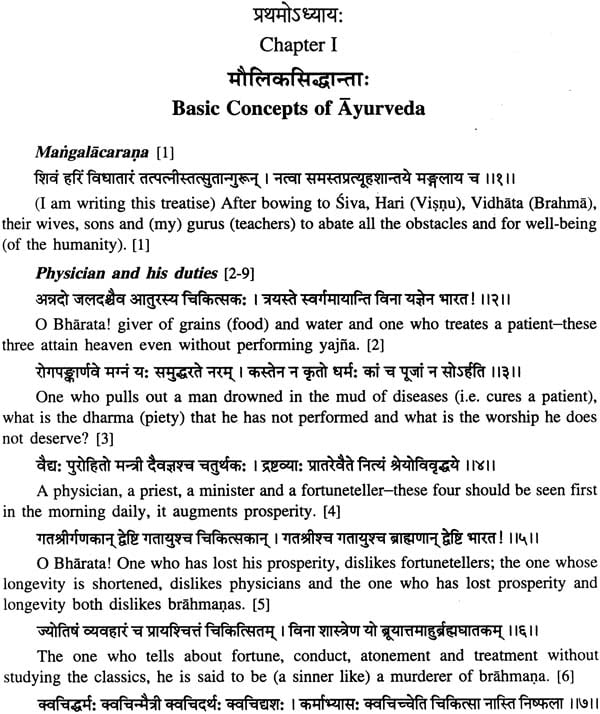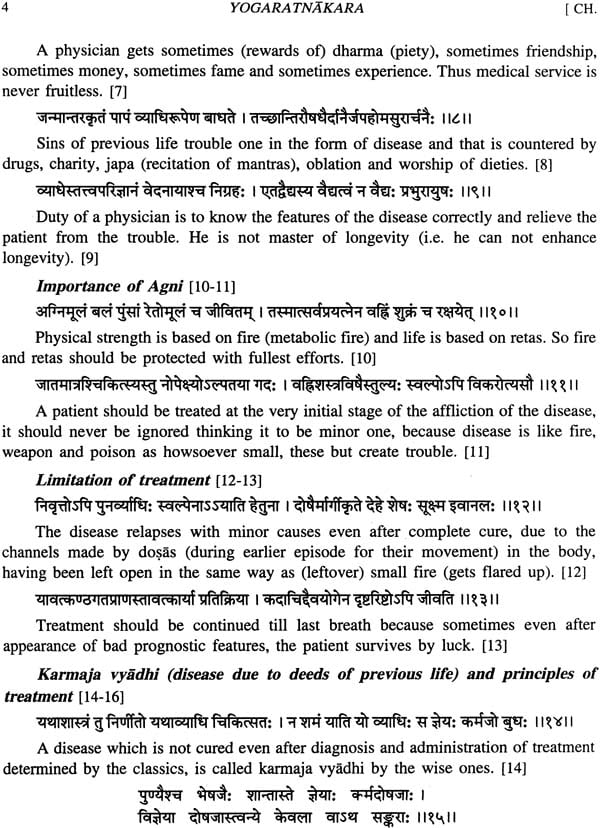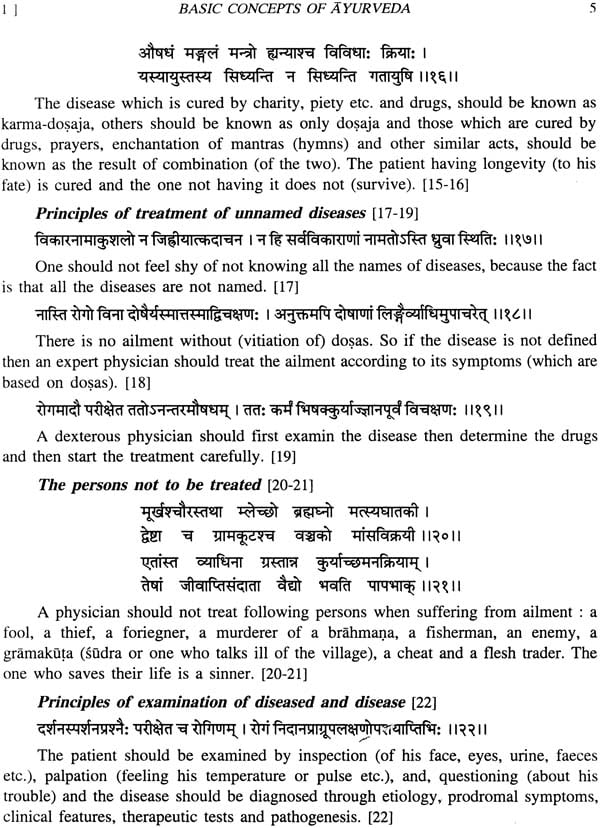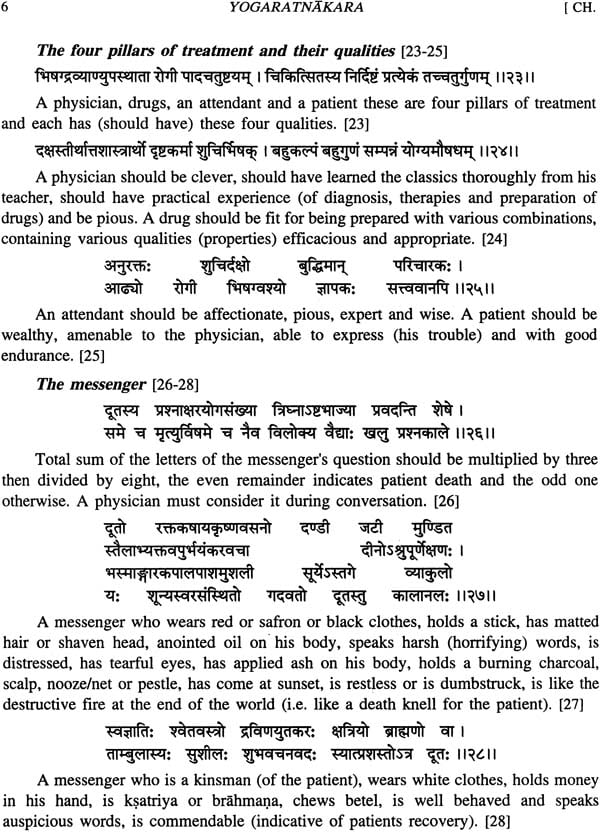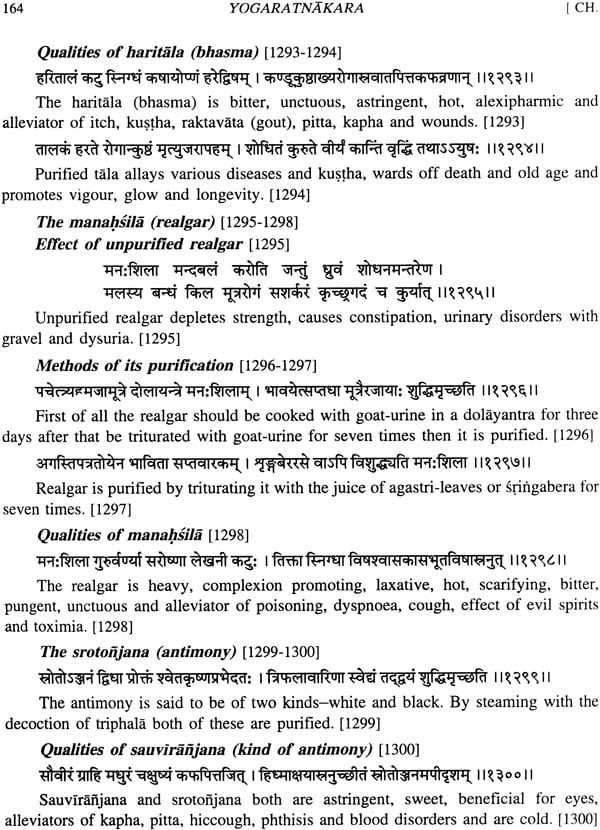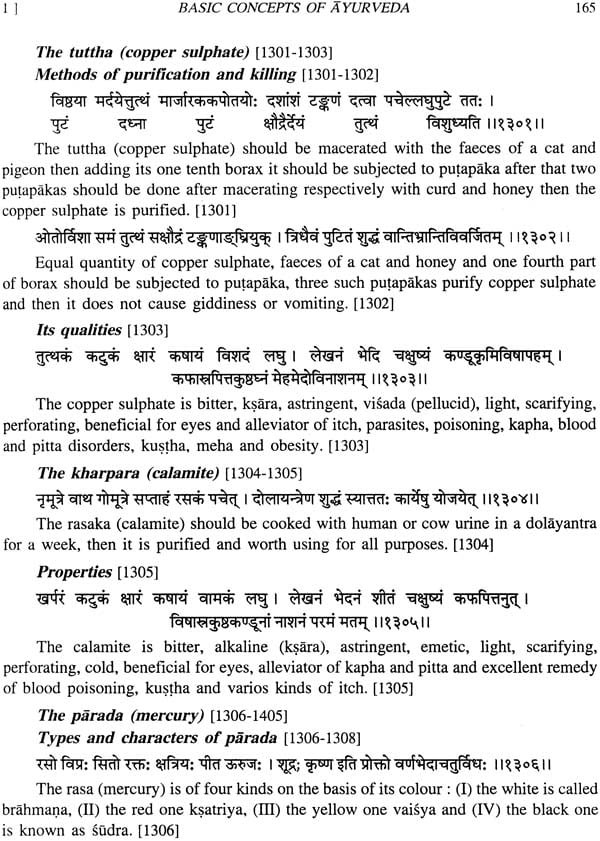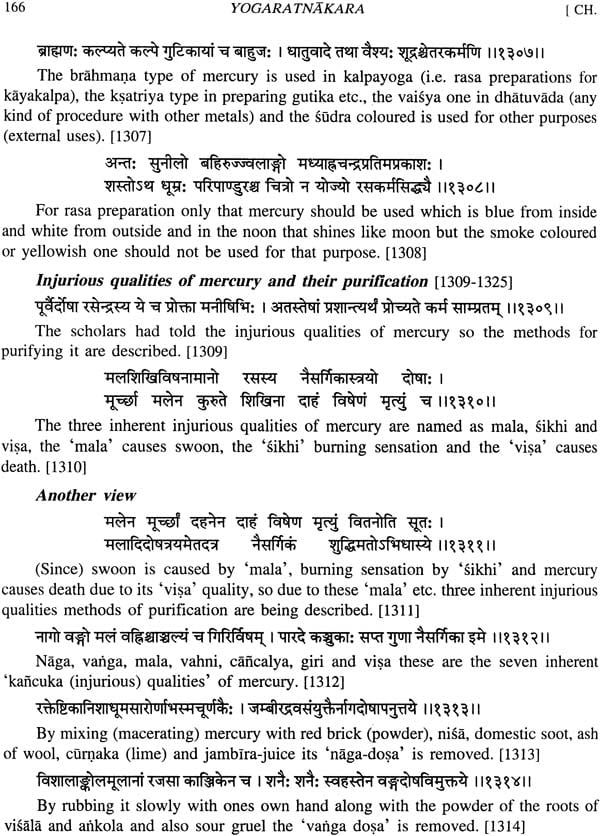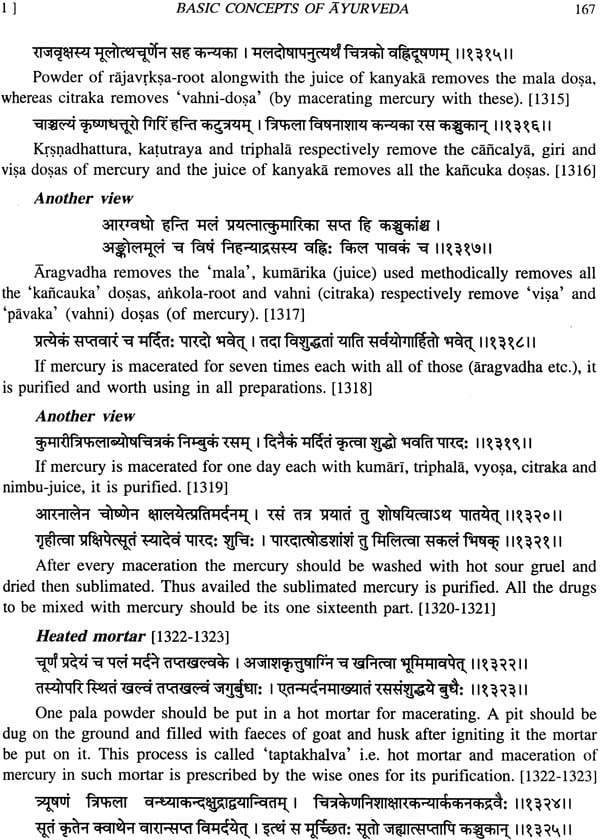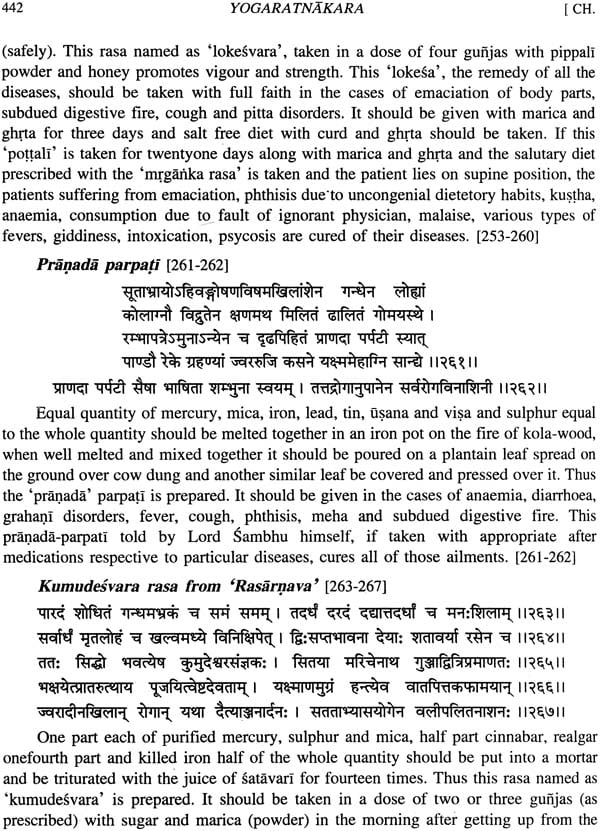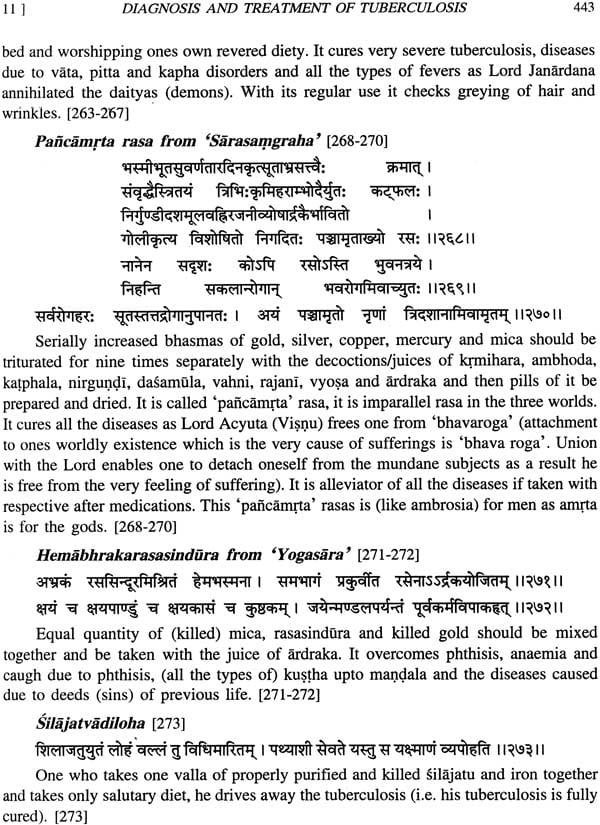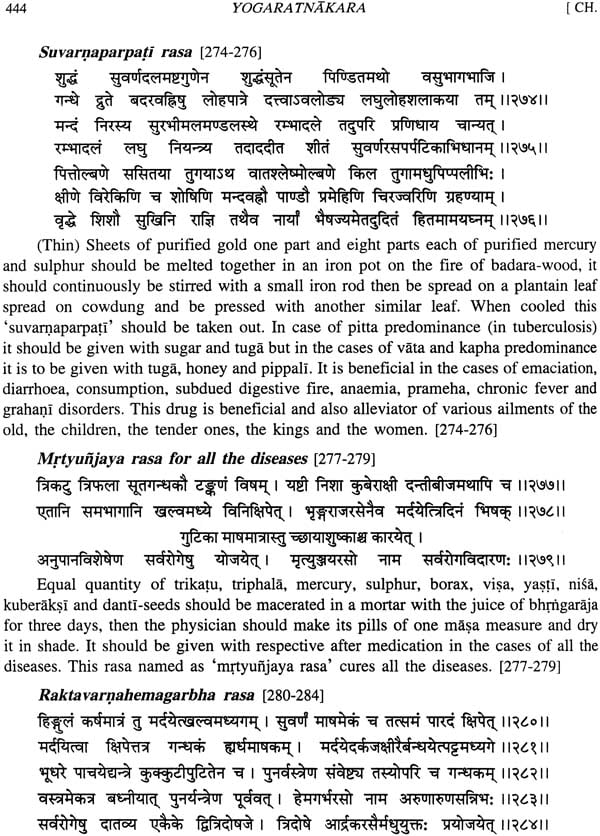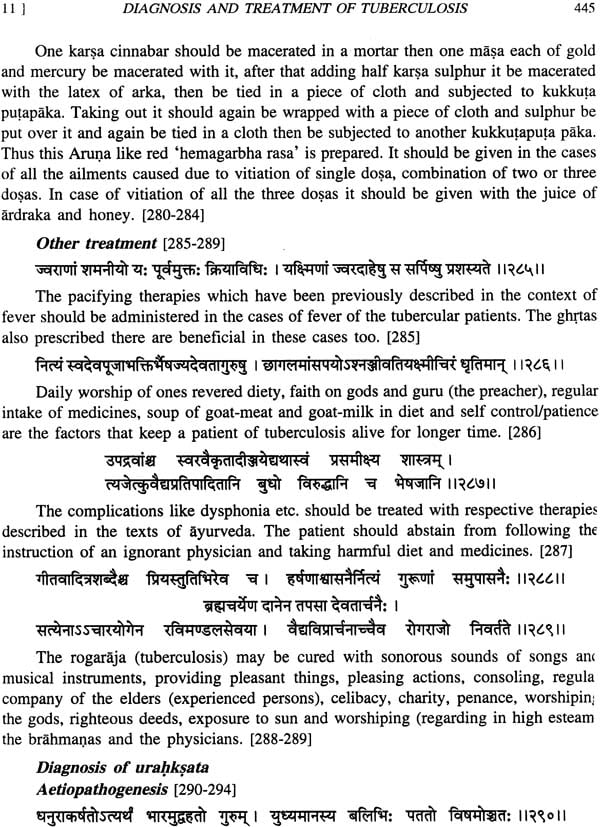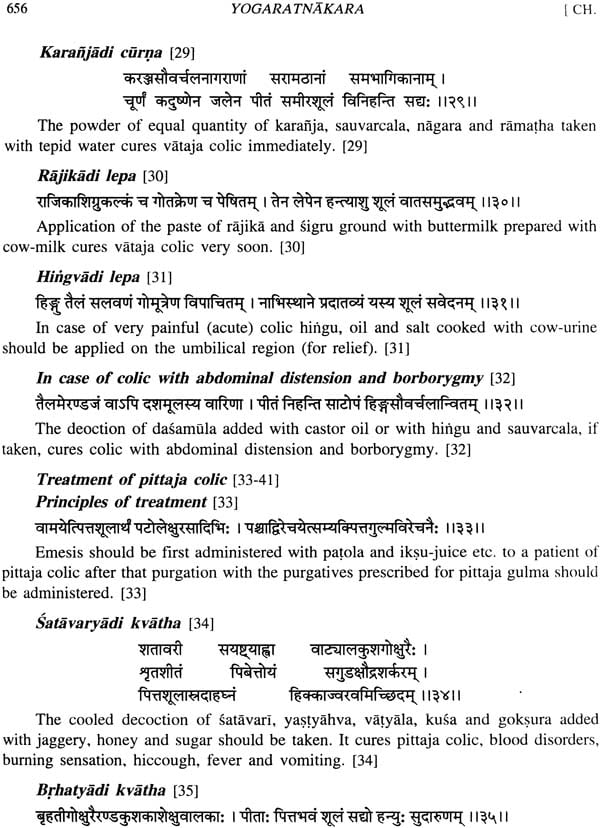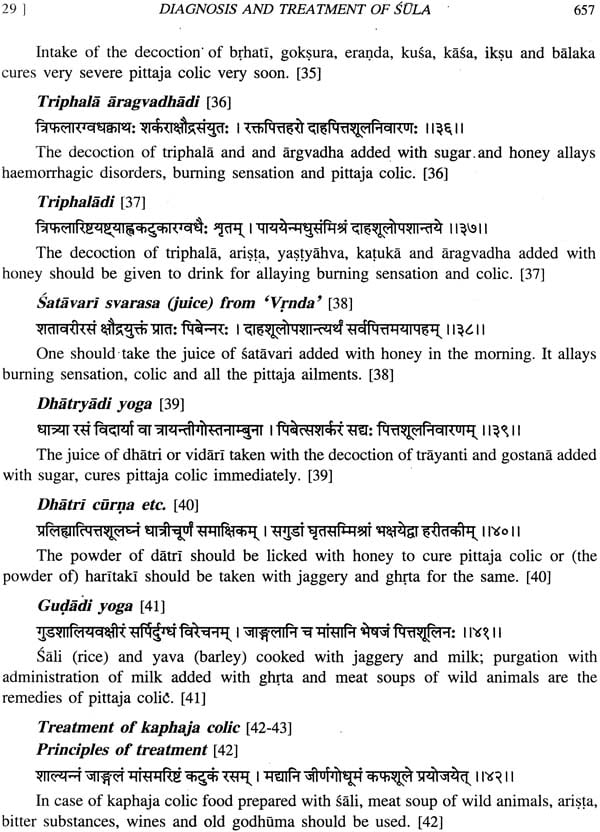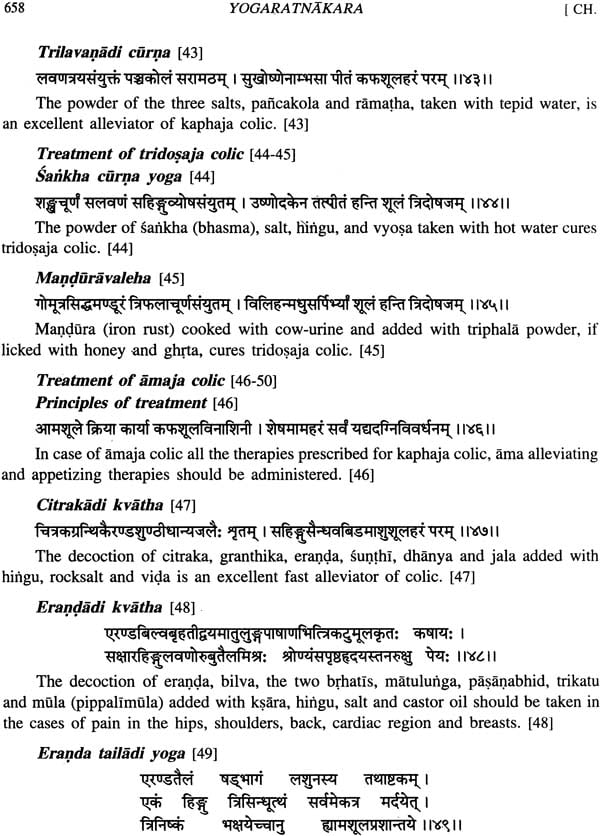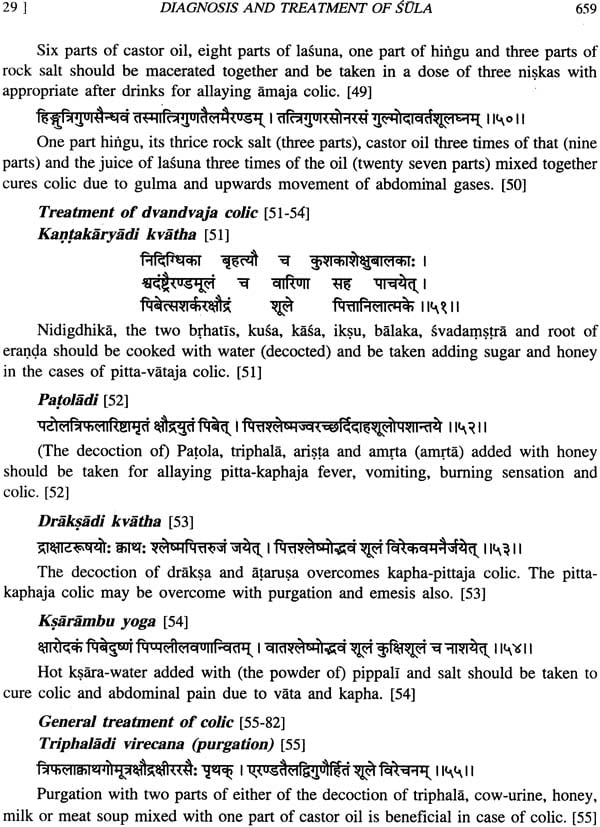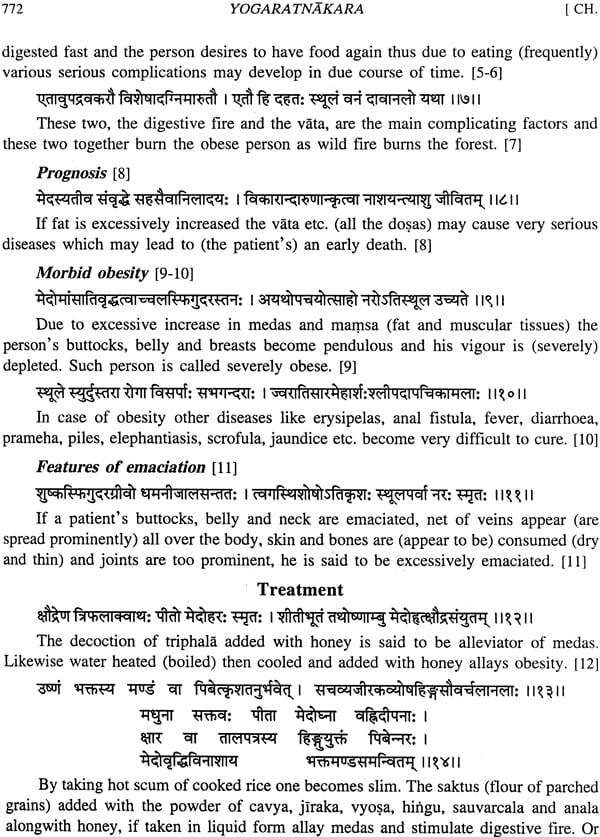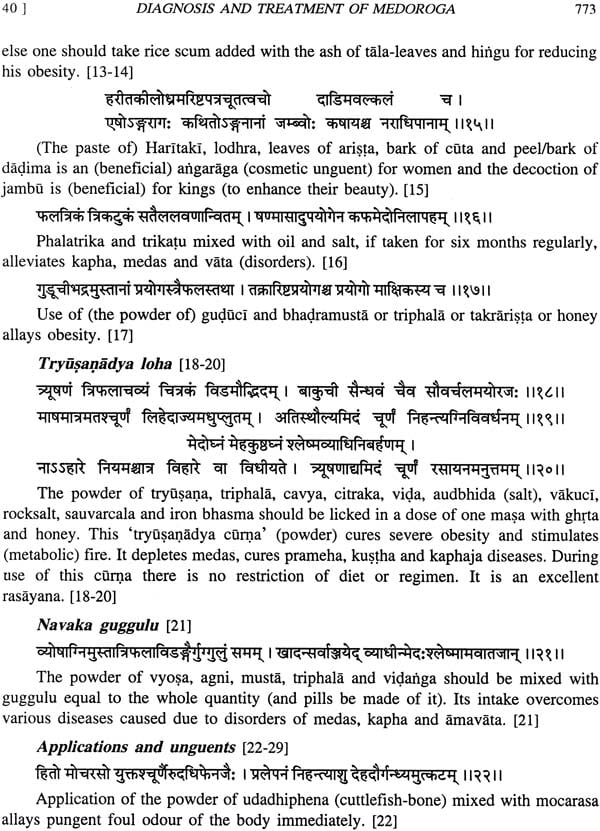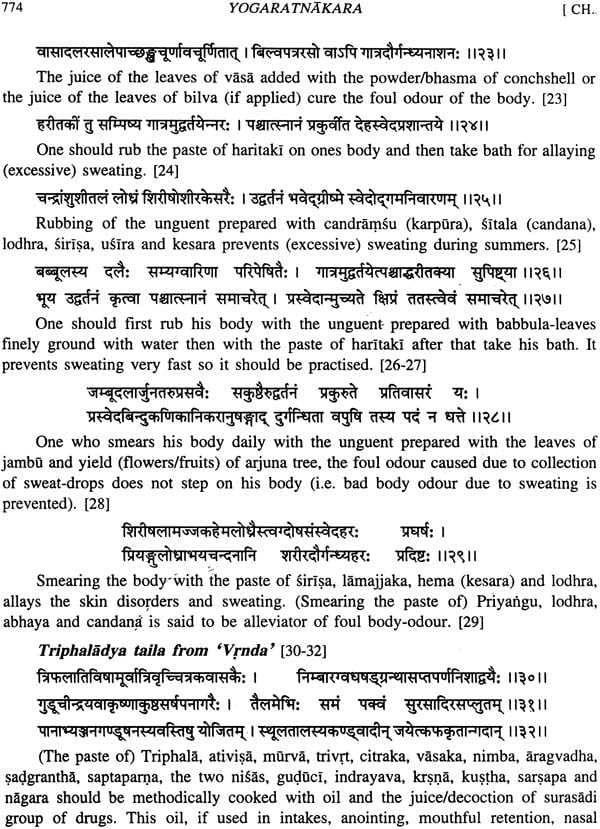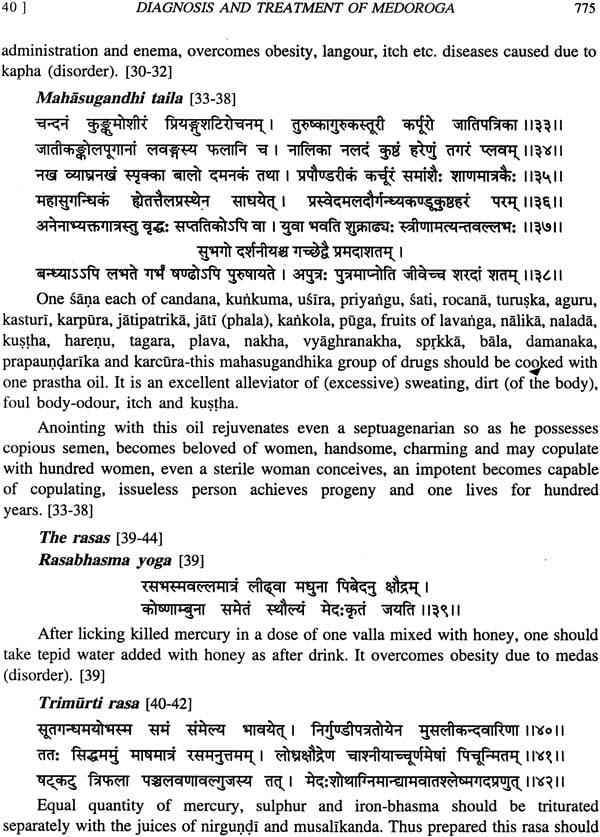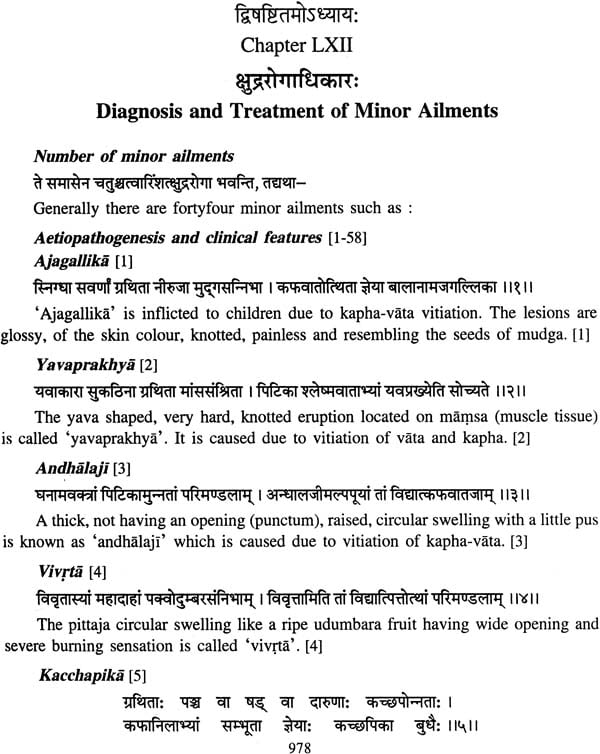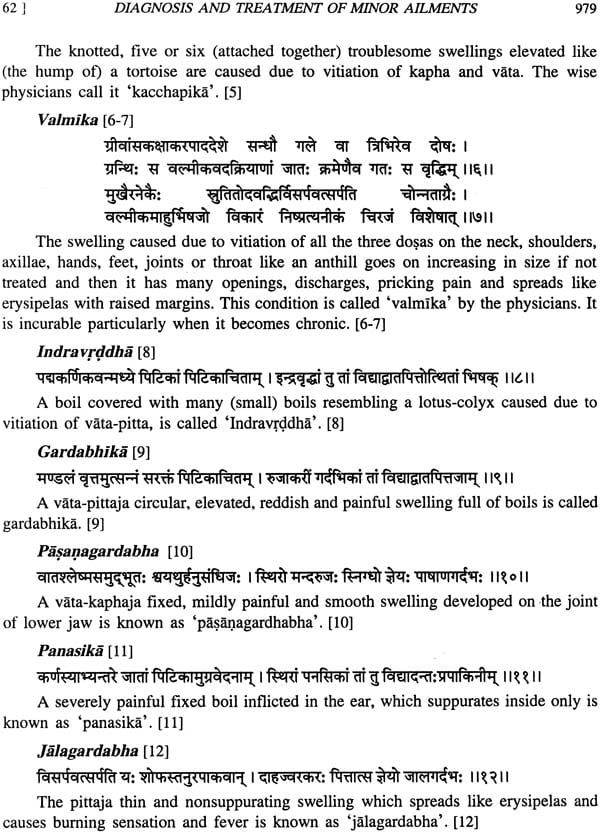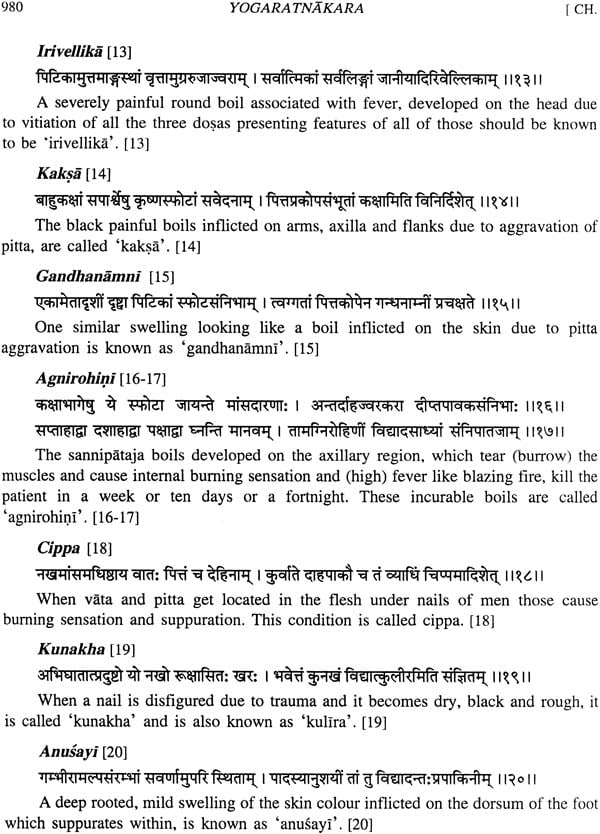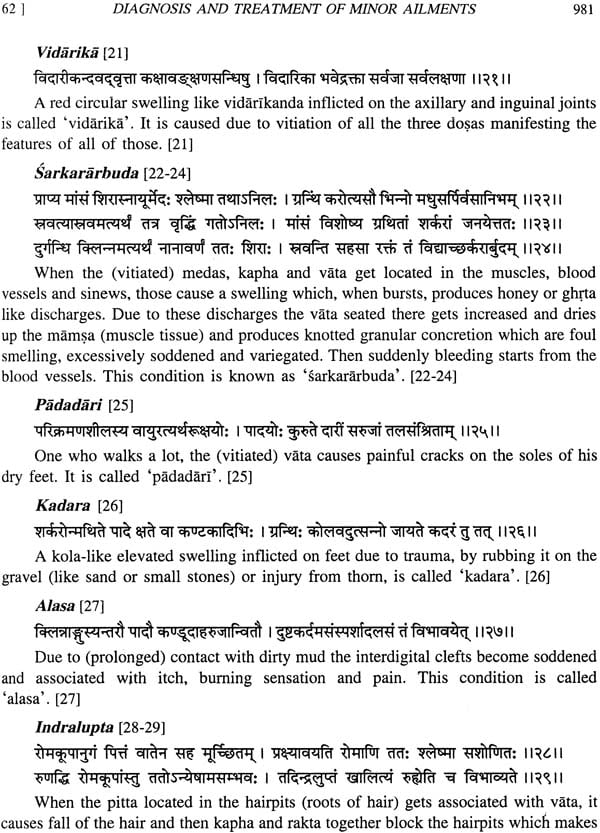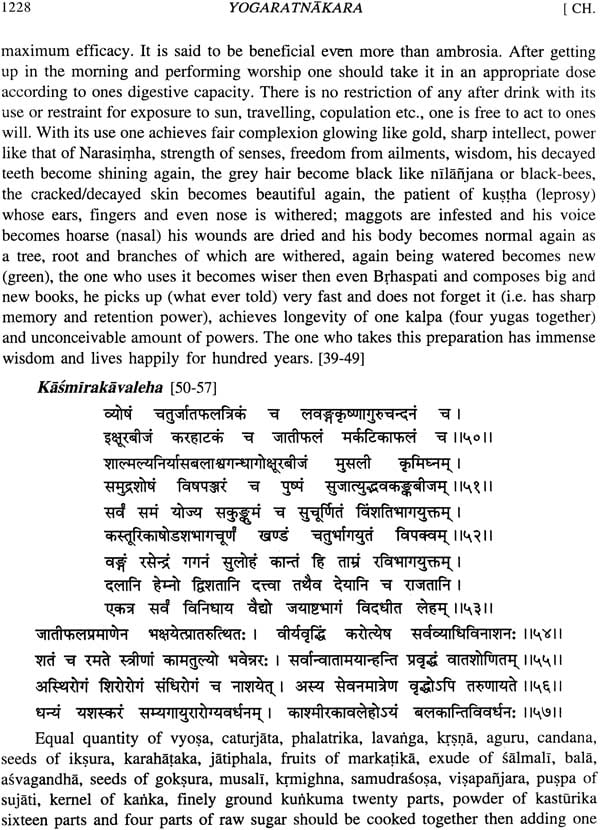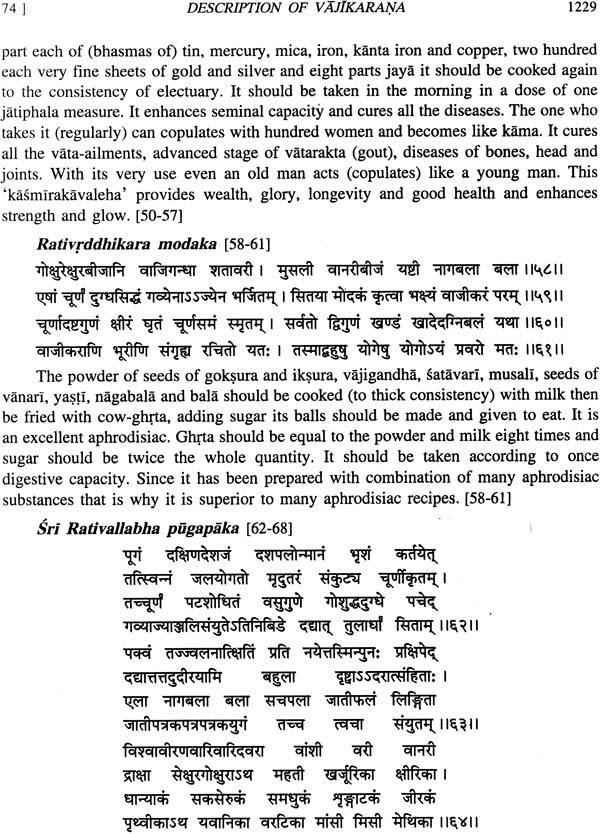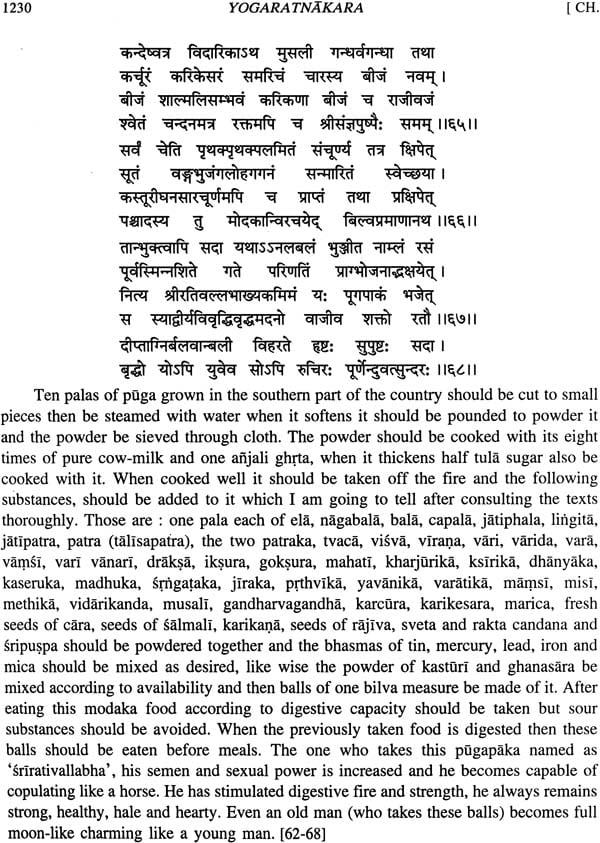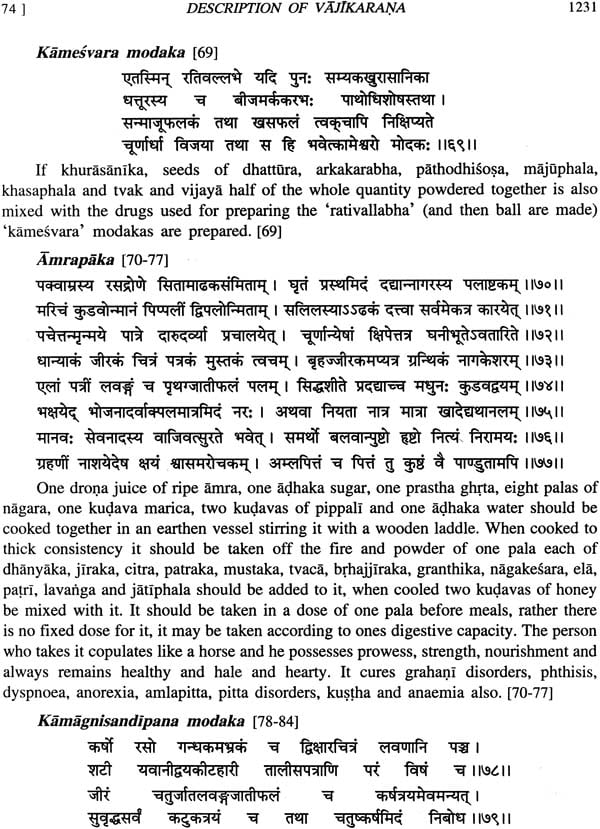
Yogaratnakara: A Complete Treatise on Ayurveda in Two Volumes
Book Specification
| Item Code: | IHL635 |
| Author: | Asha Kumari and P.V. Tewari |
| Publisher: | Chaukhambha Bharati Academy, Varanasi |
| Language: | (Sanskrit Text with English Translation) |
| Edition: | 2010 |
| ISBN: | 9788190987172 |
| Pages: | 672 |
| Cover: | Hardcover |
| Other Details | 10.0 inch X 7.5 inch |
| Weight | 2.40 kg |
Book Description
From the Jacket
Yogaratnakara the book of mid seventeenth century, written by yet unknown author, but extremely well known in the Ayurvedic world, is like a sun, throwing light on all aspects of ayurveda not seen in any other available book on ayurveda, however, since the book is compiled in the period when surgery was almost not being done by ayurvedist thus the references of subject matter related to salyavijnana (surgery) are scanty; knowledge of sarira (anotomy) being more important to surgeons also finds itself concised in few verse only. It is probably single available book which describes in detail ?astavidha pariksa? i.e. examination of pulse, urine and stool. The book is boon for those who desire to know ayurveda in depth and practice medicine only, but not dare to fathom the sea of voluminous books; as it describes in detail basic concepts of ayurveda, herbal herbomineral and metallic preparations alongwith their identification and properties of individual plant and metals or sumetals and also method of purification and killing of metals etc.; then method of preparation of recipes as well-as the dosages and after medications. After elaborating aeteopathogenesis, prodromal and clinical features, prognosis, and complications, etc. detailed preventive, promotive, rehabilitative and curative methods and also cleansing therapy (sodhana cikatsa) is given.
Present English translation done is simple language makes it accessible to those who are not well verse in hindi or samskrta. Thus the book is very useful for students, teachers and research workers all alike.
About the Author
Prof. (Km.) P.V. Tewari A.M.B.S., PhD. Adl. Med. Suptd. Mata Anandamayi Hospital (a charitable institution), Ex. H.O.D. Dept. of Prasuti Tantra, Director WHO collaborative centre, Dean of Ayurveda and Ayurvedic Pharmaceuticals I.M.S., B.H.U. elder sister of Dr. (Mrs.) Asha Kumari, daughter of freedom fighter Late Pt. Rama Sankara Tewari a recipient of Tamrapatra and Mrs. Rama Devi Tewari has produced large number of D. Ay. M./M.D. Ay. and Ph. Ds., published more than 205 research papers, edited/edited and translated/authored fourteen books. She has been associated with academic/administrative bodies of all important research and academic organizations of ayurveda of the country. He book Ayurvediya Prasuti Tantra and Striroga has received good recognition and awards.
Dr. (Mrs.) Asha Kumari M. A., Ph.D. exponent in Samskrta has acquired special experience of working on manuscripts during her work tenure with NISTADS (project on History of Science and Technology during Medieval Period). Besides editing and translating two mss of ayurveda i.e. Yogacandrika (translated in hindi and English) and Vrndamadhavaparanama Siddhayogah (translated in english) and has translated in hindi English one Prakrta Mahakavya (Setubandham) also. She has been writing articles, poems and stories in different journals and magazines on literary, social and cultural subjects. Her source of inspiration has always been ancient Samskrta literature.
Introduction
The creator of Loka i.e. the world created all the creatures and medicines medicinal plants) simultaneously, so that his best creation the human beings could have a healthy and long life with good creativity and procreativity. He also transferred the knowledge about these drugs to the coming generations through Asvini Kumaras. The first written record of this knowledge are the vedas specially me Atharvaveda. However during vedic period the medicine was magico religious. Available first literature written signally on Ayurveda are ?Caraka Samhita? and Susruta Samhita? which are well documented and systemetized. Progress of any system is always gradual, while the changes between Atharvaveda and Caraka and Susruta Samhitas appears to be drastic and the time gap between these two eras extends to thousands of years. The process and means of these changes are in oblivion.
Though ?Caraka Samhita? and ?Susruta Samhita? represent two different schools/systems of specialization i.e. the medical and surgical systems respectively yet those have dealt with all the eight specialized branches of Ayurveda. This very pattern of writing the books with minor modifications here and there persisted for centuries.
Madhavakara was the first author to deviate from this way of writing the Ayurvedic literature by bifurcating the existing system into two i.e. the diagnosis and treatment dealt in two separate treatises. Probably he might have done it to facilitate memorization and recapitulation by the learners of the subject, more so because the books is written totally in verses. ?Madavanidana? as the name itself insinuates deals with aetiopathogenesis and clinical features etc. aspects related to diagnosis of the diseases. Since the author has derived knowledge from the existing literature, it can also be considered as the first book mainly based on compilation with elaboration. Later he wrote a book on treatment. In the field of diagnosis his book stands supreme rather alone, however ?Vrnda Madhava? and ?Cakradatta? etc. later authors followed the pattern of second book and wrote treatises on only treatment.
Though for diagnosing the diseases and knowing the status of the patient trividha, pancavidha, sadvidha and dasavidha pariksas (ways of examination) were in practice yet the currently used method by the vaidyas i.e. nadipariksa (examination of pulse etc.) were absent. Later with the inclusion of nadipariksa during medieval period books were written on this subject also. The period when the astavidhapariksa came into practice is a bit confusing due to lack of available literature.
Later period of Ayurveda is mainly characterized with compilations that too on separate subjects like nighantus on drugs, books on rasa cikitsa, treatment, nadipariksa etc.
Among the available literature ?Yogaratnakara? is one treatise that deals with Ayurveda in its entirety but for sarira and salya that too in a very organized and different way. Probably owing to the fact that nobody who wants to learn Ayurveda, whether a student or a practitioner, has time enough to go through all the texts, moreover availability of all sorts of literature to any individual was then and is even now a problem. So the sagacious author of ?Yogaratnakara? compiled all the relevant aspects of the science necessary for a student or a practitioner of Ayurveda, in one book. Starting from the qualities and duties of a physician the book elaborates the four pillars necessary for the treatment i.e. the physician, the means of treatment, the attendant and the patient, indication of curability or otherwise according to the presentation of the messenger or other omens and then it comes to astavidha pariksa i.e. the eight measures of diagnosis as nadipariksa (pulse examination), mutra pariksa (urine examination), mala pariksa (stool test), sabda pariksa (diagnosis through voice of the patient), drk pariksa (diagnosis through touch), rupa pariksa (diagnosis through the look of the patient), drk pariksa (eye examination), asya pariksa (mouth examination) including jihva pariksa (tongue examination). After that the author describes the time periods i.e. the seasons, months and also parts of a day for respective aggravation of the dosas, signs of mature or immature stage of diseases; stages of development according to age; effect of dosas on the individual prakrti (nature on the whole); features of healthy body; weights and measures along with their synonyms according to magadha and kalinga schools; qualities of grains, vegetables, fruits and different types of meat, types and qualities of cooked cereal preparations; qualities of different types of drinks; qualities of some other edible preparations; features of life expectancy of the patients; regimen for day and night and also according to different seasons; qualities of different types of water (like cold, hot, boiled etc.); qualities of different types of milk, curd, butter, ghrta, oil, honey, sugar etc.; qualities of eight types of urine (procured from different sources); various groups of drugs; kasaya kalpana (methods of preparing paste, decoction, cold percolation etc.); qualities and methods of purification and killing of all the metals, substitute, gems and some drugs/herbs also; abhava varga i.e. substitute substances; the cleansing and theraputic methods; definition of some specific terms like drowsiness, yawning etc. and then enumeration of all the diseases is taken up in the treatise. Finally diagnosis and treatment of individual diseases is described in each of the seventy two chapters. The last four chapters classified as ?uttarakhanda deal with vajikarana (aphrodisiac recipes), rasayana (youth and longevity providing recipes), rasavaikrti (complications due to improper use of mercury) and roganusaranupana (appropriate after drinks).
<
| 1 | Basic Concepts of Ayurveda | 3-207 |
| Mangalacarana | 3 | |
| Physician and his duties | 3 | |
| Importance of Agni | 4 | |
| Limitation of treatment | 4 | |
| Karmaja vyadhi (disease due to deeds of previous life) and principles of treatment | 4 | |
| The four pillars of treatment and their qualities | 6 | |
| The messenger | 6 | |
| Auspicious omens | 7 | |
| Examination of eight points of the patients | 7 | |
| Determination of period for patient?s prognostication | 20 | |
| Determination of place | 22 | |
| Months when vata etc. dosas are aggravated | 22 | |
| Seasons when dosas are aggravated | 23 | |
| Functions of the three dosas | 23 | |
| Pacificative measures for the three dosas | 24 | |
| Stages of life | 24 | |
| Description of prakrti (i.e. constitution) | 26 | |
| Signs of healthy state | 27 | |
| Definitions of measures | 27 | |
| Magadha measures | 27 | |
| The definition of kalinga measures | 29 | |
| Properties of grains, fruits, bulbous roots, rhizomes and vegetables etc. | 29 | |
| Properties of tamakhu i.e. tobacco | 29 | |
| The properties of meat | 42 | |
| Features of anupa i.e. marshy and aquatic creatures | 43 | |
| Properties of jangala meat | 43 | |
| Properties of the meat of marshy and aquatic animals | 45 | |
| Qualities of cooked eatables and potables | 48 | |
| Qualities of drinks | 56 | |
| Qualities of Ragakhandava | 58 | |
| Qualities of Rasala-skharini | 58 | |
| Consideration about longevity | 59 | |
| Description of proper daily routine | 63 | |
| Dinacarya (daily routine of life) | 63 | |
| Natural desires (effect of their suppression) | 74 | |
| Importance of taking food | 74 | |
| Effect of wind | 85 | |
| Comfort providing routine | 89 | |
| Ratricarya (proper activities during night) | 92 | |
| Rtucarya (prescribed routine for different seasons) | 100 | |
| Accumulation, aggravation and pacification of dosas in different seasons and their effect | 100 | |
| Qualities of cold water | 104 | |
| Qualities of medicated/nonmedicated hot water | 104 | |
| Qualities of milk | 106 | |
| Qualities of curd | 112 | |
| Takra (buttermilk) and its qualities | 114 | |
| Qualities of navaneet (butter) | 116 | |
| Qualities of ghrta | 117 | |
| Qualities of taila (oils) | 118 | |
| Qualities of madhu (huney) | 120 | |
| Qualities of iksu (sugarcane) | 122 | |
| The eight types of urine | 124 | |
| Groups of drugs | 125 | |
| Kasayas | 131 | |
| Preparation of silajatu | 140 | |
| Common features, purification, killing and qualities of dhatus (metals), submetals and ohters | 140 | |
| The metals | 140 | |
| Upadhatus (submetals) | 140 | |
| Wholesome and unwholesomes being used with mercury preparations | 176 | |
| Tatna (gems) and others | 178 | |
| The silajatu (bitumen) | 181 | |
| Killing of visa | 186 | |
| Upavisas (sub-poisons) | 187 | |
| Satwapatana (metallic extraction) of abhraka (mica) | 190 | |
| Preparation of ksara | 191 | |
| The abavagarga (substitute drugs) | 191 | |
| Virya (potency of action) and vipaka (final metabolism) of drugs | 196 | |
| Cleansing therapies | 196 | |
| Definitions of words (names or features of some ailments) and list of described diseases | 205 | |
| The order of fever etc. diseases | 206 | |
| 2 | Diagnosis and Treatment of Fever | 208-289 |
| Origine of fever | 208 | |
| Pathogenesis | 208 | |
| Prodromal features | 208 | |
| General features of fever | 209 | |
| Clinical features of fevers | 209 | |
| Course of sandhika etc. all sannipataja fever | 211 | |
| The prognosis | 212 | |
| Specific features of these thirteen sannipatika fevers | 212 | |
| Prognosis of sannipata | 215 | |
| Features of malapaka or dhatupaka | 216 | |
| Exogenous fevers | 216 | |
| Visamajwara (intermittent fever) | 217 | |
| Pathogenesis of intermittent fevers | 218 | |
| Features of intermittent fever | 218 | |
| Types and their locations | 218 | |
| Status of dosas in these fevers | 219 | |
| Complications of fever | 220 | |
| Features of proper langhana in febrile case | 221 | |
| Features of afebrile stage | 221 | |
| Treatment | 221 | |
| Treatment of fever in a proper order (principles of treatment in sequential order) | 221 | |
| Importance of fasting | 222 | |
| Period of paka (maturing) of fever | 222 | |
| The period for starting decoctions etc. | 223 | |
| Time for giving diet | 223 | |
| Importance of pitta in fever | 224 | |
| Period of drug administration to febrile case | 224 | |
| Principles of treatment of recently inflicted fever | 225 | |
| Dosages of drugs | 228 | |
| Period of efficacy of various drugs | 230 | |
| Period for administering these drugs | 231 | |
| Remedy of fever with rigor | 237 | |
| Principles of treatment in sannipataja fever | 238 | |
| Treatment of fever situated in dhatus | 238 | |
| Other general treatment/principles | 238 | |
| Treatment of sannipataja fever | 245 | |
| Treatment of exogenous fever | 255 | |
| The intermittent fevers | 256 | |
| Treatment of intermittent fevers | 257 | |
| Other treatments of intermittent fevers | 259 | |
| Application in the eyes and fumigation | 263 | |
| The curnas for the treatment of fever | 264 | |
| The ghrtas | 270 | |
| The oils | 271 | |
| The rasas (metallic preparations) | 274 | |
| Features of fever lodged in the seven dhatus | 283 | |
| Treatment of the fevers lodged in seven dhatus | 283 | |
| Manthara (law grade) fever | 284 | |
| Treatment | 284 | |
| Treatment of the fever due to (use of) contaminated water | 285 | |
| General principles of salutary and non-salutary regimen for the patients of fever | 285 | |
| Pacana (factors) of recently inflicted fever | 286 | |
| Beneficial/effective therapies for sannipata | 286 | |
| Unwholesomes in case of recently inflicted fever | 287 | |
| Wholesomes | 287 | |
| 3. | Diagnosis and Treatment of Diarrhoea | 290-316 |
| Aetiopathogenesis of Atisara (diarrhoea) | 290 | |
| Prodromal features | 291 | |
| Clinical features | 291 | |
| Features of amatisara | 292 | |
| Features of ama | 292 | |
| Features of pakvatisara | 292 | |
| Bad prognostic features | 292 | |
| Complications of diarrhoea | 293 | |
| Pravahika (dysentery) | 293 | |
| Features indicative of cure of diarrhoea | 293 | |
| Aetiopathogenesis of fever with diarrhoea | 294 | |
| Features of incurable/fatal diarrhoea | 294 | |
| Treatment | 294 | |
| Treatment of diarrhoea at the stage of its prodromal features | 294 | |
| Treatment of amatisara | 295 | |
| Treatment of pakvatisara (diarrhoea with digested food) | 298 | |
| Treatment of blood mixed diarrhoea | 301 | |
| Piccha basti | 303 | |
| Treatment of anorectal prolapse | 303 | |
| Treatment of diarrhoea with oedema | 307 | |
| Treatment of dysentery | 307 | |
| Purisaksaya (deficiency of faeces) | 307 | |
| Treatment of fever with diarrhoea | 308 | |
| Treatment of all the types of diarrhoea | 309 | |
| Treatment of all the types of diarrhoea | 311 | |
| The rasa (metallic preparations) | 314 | |
| Wholesomes for diarrhoea patients | 315 | |
| Unwholesomes for the diarrhoea patients | 316 | |
| 4 | Diagnosis and Treatment of Grahani (disorders) | 317-332 |
| Aetiopathogenesis | 317 | |
| Location of grahani membrane | 317 | |
| Classification and general clinical features of grahani | 317 | |
| Prodromal features | 318 | |
| Ama grahani | 319 | |
| Features of incurable grahani | 319 | |
| Prognosis according to age | 320 | |
| Treatment | 320 | |
| General treatment of grahani diseases | 322 | |
| The wholesomes | 332 | |
| Unwholesomes | 332 | |
| 5 | Diagnosis and Treatment of Piles | 333-348 |
| Diagnosis of piles | 333 | |
| Etymology of arsa (piles) | 333 | |
| Classifications | 333 | |
| General features of piles | 333 | |
| Prodromal features of piles | 334 | |
| Clinical features | 334 | |
| Involvement of vata etc. dosas in raktaja piles | 336 | |
| Aggravation of all the three dosas (being the cause) | 336 | |
| Prognosis | 337 | |
| Piles (like lesion) on the other parts of the body | 338 | |
| Clinical features of carmakila | 338 | |
| Treatment | 338 | |
| Type of treatment | 338 | |
| The ghrtas | 346 | |
| The pastes for local application | 347 | |
| The rasas | 348 | |
| Wholesome and unwholesome regimen | 348 | |
| 6 | Diagnosis and Treatment of Depleted Digestive Fire | 349-352 |
| Types of digestive fire | 349 | |
| Features of sama and visama etc. digestive fire | 349 | |
| Treatment | 349 | |
| Aetiology and clinical features of bhasmaka | 350 | |
| Diagnosis aetiology | 351 | |
| Treatment | 351 | |
| 7 | Diagnosis and the Treatment of Indigestion | 353-373 |
| Definition of ama | 353 | |
| Classification | 353 | |
| Aetiology | 353 | |
| Clinical features | 354 | |
| Complications of indigestion | 354 | |
| The visuci | 355 | |
| Features of alasaka | 355 | |
| Features of vilambika | 356 | |
| Sequela of ama | 356 | |
| Prognosis | 356 | |
| Features of proper digestion of food | 356 | |
| Treatment | 256 | |
| Principles and general treatment | 356 | |
| The powders | 356 | |
| The pills | 358 | |
| Electuaries | 360 | |
| The decoctions | 362 | |
| The ghrtas | 363 | |
| The groups of substances to counter indigestion | 364 | |
| The rasas | 365 | |
| Treatment of visuci etc. | 371 | |
| Non salutary diet in ajirna etc. | 373 | |
| Salutary things | 373 | |
| 8 | Diagnosis and Treatment of Parasites | 374-379 |
| Kinds of parasites | 374 | |
| External parasites | 374 | |
| Aetiology of parasites | 374 | |
| Features of infestation of parasites | 375 | |
| Complications | 376 | |
| Treatment | 376 | |
| The dococtions | 376 | |
| The powders | 377 | |
| Recipies for getting rid of the lice | 378 | |
| Unwholesomes during the trouble of parasites | 379 | |
| 9 | Diagnosis and Treatment of Anaemia | 380-392 |
| Types and Aetiopathogenesis of anaemia | 380 | |
| The prodromal features of anaemia | 380 | |
| Clinical features | 380 | |
| Prognosis of anaemia | 382 | |
| Aetiology of kamala (jaundice) | 382 | |
| Clinical features of jaundice | 382 | |
| Kumbhakamala (? Jaundice with ascites) | 383 | |
| Incurable kamala | 383 | |
| Incurable kumbhakamala | 383 | |
| Halimaka (? chlorosis) | 383 | |
| Features of panaki | 383 | |
| Treatment | 384 | |
| Decoctions | 384 | |
| Iron preparations for anaemia | 385 | |
| Treatment of jaundice and halimaka | 387 | |
| Wholesomes and unwholesomes | 392 | |
| 10 | Diagnosis and Treatment of Haemorrhagic Disorders (raktapitta) | 393-408 |
| Aetiopathogenesis | 393 | |
| Prodromal features | 393 | |
| Clinical features of raktapitta | 393 | |
| Prognosis | 394 | |
| Complications of haemorrhagic disorders | 395 | |
| Character of blood and other features indicating incurability | 395 | |
| Treatment | 395 | |
| Decoctions, medicated milk etc. for treatment | 397 | |
| External use of drugs | 401 | |
| Ghrtas | 402 | |
| Awaleha/Khanda | 404 | |
| The rasas | 407 | |
| 11 | Diagnosis and Treatment of Tuberculosis | 409-450 |
| Diagnosis of tuberculosis | 409 | |
| Etymology of the names | 409 | |
| Aetiological factors | 409 | |
| Pathogenesis | 409 | |
| Prodromal features | 410 | |
| Clinical features | 410 | |
| Prognosis of tuberculosis | 411 | |
| Types of other sosas (consumption) | 411 | |
| Life expectancy of yaksma-patient | 413 | |
| Importance of sukra and mala of yaksma-patient | 413 | |
| Treatment | 413 | |
| Non-congenials | 414 | |
| Salutary articles | 414 | |
| Decoctions | 415 | |
| Churnas | 415 | |
| The ghrtas | 416 | |
| The oils | 426 | |
| Asava/Aristas | 429 | |
| The rasa (metallic) preparations | 431 | |
| Other treatment | 445 | |
| Diagnosis of urahksata | 445 | |
| Clinical features of urahksata | 446 | |
| Prodromal features | 446 | |
| Prognosis | 446 | |
| Treatment of urahksata | 447 | |
| Ghrtas | 448 | |
| 12 | Diagnosis and Treatment of Cough | 451-474 |
| Aetiology | 451 | |
| Pathogenesis | 451 | |
| Their number (types) | 451 | |
| The prodromal features | 451 | |
| Clinical features of cough | 451 | |
| Prognosis | 452 | |
| Treatment | 453 | |
| Specific treatment according to causative factors | 454 | |
| Treatment of cough with dyspnoea | 459 | |
| Recipes for all the types of cough | 460 | |
| The rasas (metallic preparations) | 468 | |
| Wholesomes and unwholesomes | 473 | |
| 13 | Diagnosis and Treatment of Hiccough | 475-481 |
| Aetiology | 475 | |
| Pathogenesis | 475 | |
| Prodromal features | 475 | |
| Its nomenclatures/types | 475 | |
| Clinical features | 476 | |
| Prognosis | 476 | |
| Treatment | 477 | |
| Wholesomes and unwholesomes | 481 | |
| 14. | Diagnosis and Treatment of Dyspnoea | 482-491 |
| Aetiology | 482 | |
| Pathogenesis | 482 | |
| Classification | 482 | |
| Prodromal features of dyspnoea | 482 | |
| Clinical features | 483 | |
| Bad prognosis of the chinnasvasa | 484 | |
| Prognosis of ksudra etc. | 485 | |
| Treatment | 486 | |
| The decoctions | 486 | |
| The electuaries | 488 | |
| The wholesomes and unwholesomes | 490 | |
| 15. | Diagnosis and Treatment of Svarabheda (hoarseness of voice) | 492-496 |
| Aetiopathogenesis | 492 | |
| Clinical features | 492 | |
| Prognosis | 493 | |
| Treatment | 493 | |
| 16. | Diagnosis and Treatment of Anorexia | 497-505 |
| Classification | 497 | |
| Aetiology in general and clinical features of vataja anorexia | 497 | |
| Clinical features | 497 | |
| Treatment | 498 | |
| The recipes for mouth wash | 499 | |
| The pills | 500 |
